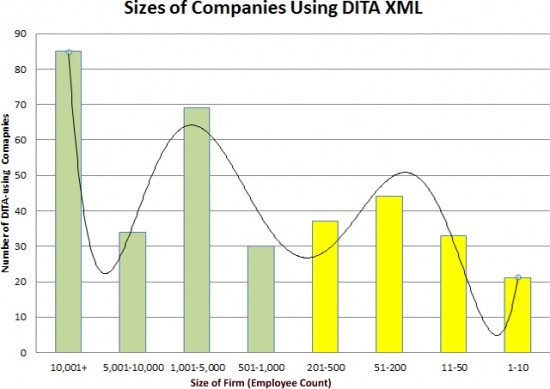
Recently I ran across another blog post that extensively referenced one of my recent articles here looking at the sizes of the types of companies that are using DITA. I considered posting a response to it directly on their site, but I figure I can do a better job of it if I can include a chart to illustrate my point.
The blog post in question wonders aloud whether or not the relative success or failure of DITA adoption within companies may in fact emulate a Power Law, which would show that most of the market can be split among the big players, and the remainder being the classic “long tail”. He believes that DITA is “a solution aimed primarily at ‘big player problems’” and states that if DITA adoption by big and small companies does follow a Power Law distribution, it would mean that it is successful only with big firms and not with smaller ones.
It would be true if that were the case. But it’s not.
Here’s the graph he uses to show what a Power Law distribution would be like:

If I re-graph the numbers from my original pie chart in the same manner as this chart, this is what you get:

Clearly these things are not the same. The line I’ve added is a trend line showing clearly that there are in fact at least three peaks in terms of the sizes of the firms using DITA: one with the largest (10,000+ employees) firms, another with the medium-to-large sized (1,001-5,000 employees) firms, and a third clustered around small-to-medium sized (51-200 employees) firms. You could still argue that on the whole it tends to be larger companies that choose to use DITA (and to fair I said as much in my original article) but the distribution we see here definitely does not match the standard Power Law curve, and more closely matches a classic “triple peak”. While it is true that the data is informally-derived, what I didn’t say before is that the amount of mathematical confidence that these numbers show a real trend is high given the relatively large sample size.
You could still argue that the majority of firms using DITA tend to be larger firms, but you just can’t deny that a considerable number of smaller firms are also using DITA.
Okay, that’s busted. The more interesting question though is why? Why does DITA seem to work well in companies of large, medium and small sizes?
More on that in the next DITAWriter article…

Keith
It’s great that you have provided this follow up, and it would be really useful if you continue your research into the take up of DITA.
I still don’t think there’s sufficient evidence yet to make any firm conclusion about this. Indeed, in your original post you said “this information is informal and somewhat “shallow””. You could be right that DITA is a tool with equal attraction to both big and small companies – there needs to be more data.
Actually, we have an open mind over DITA – we recommend it to some clients and not to others. I think there’s a place for those to champion DITA and for others to challenge their assertions.
Hopefully, as more research and data emerges, and the debates continue, we’ll all be in a better position to judge the adoption rates for DITA and its place within technical communication.
I agree that more research needs to be done, and I am happy to continue doing my informal, unpaid researches in this area because it is of interest to me (and because nobody else seems to be doing it, or making their results public).
I do wonder what your definition of “more data” is though, since with a listing of nearly 400 companies using DITA that is arguably a good sample size, and running a level of confidence on the numbers suggests that they are accurate to a 95% level 4 times out of 5. So the trend we see now for all intents can be considered to be “real”. Explaining *why* that is the case is the more interesting question to me at this point, which I plan on talking about in a follow-up article or two.
Hi, Keith, I wonder if we aren’t mixing up absolute and relative numbers in the argument? Your chart clearly shows that we have 45 companies with 51-200 employees using DITA vs. only 35 companies with 5,001-10,000 companies. But what are the numbers of companies and the ratios of using DITA vs. not using DITA in each size bracket?
The Power law applies to the distribution of company sizes: Few large companies vs. a long tail of small companies. I think if you map the distribution ratios of DITA across company sizes, you’re probably closer to a Power law distribution once again.
85 companies of 10k+ employees use DITA. That may be a sizable ratio, if there are fewer than 1,000 companies of that size (I’m only guessing, I don’t know what market we’re looking at).
By contrast, 45 companies with 51-200 employees may already be part of the long tail, if there are more than 10,000 companies of that size total.
I doubt that comparing the number of companies using DITA vs. not is a useful comparison, especially since it is next to impossible derive what the latter figure would be. I think you have to go with what the research shows, rather than skewing things with numbers we don’t (and likely can’t) have in order to make things “fit” a different theory. It is safe to say that there are more smaller firms than larger ones in the world, but how many of them produce tech docs and of those who have even *heard* of DITA must be a significantly smaller number, and that would be the number you would arguably want to compare these numbers with.
All I can honestly say at this point the numbers don’t follow a classic Power Law curve, though there is a clear trend towards larger companies adopting DITA.
It is also easier for me to find information about larger companies using DITA (they tend to be more public in their acknowledgement of using DITA, and there are correspondingly more people using DITA) so I suspect that in fact the lower end of things is under-reported. Even so, the spread is more even than I would have expected.
In any event I will keep on adding to my list and look for emerging trends. Thanks for the comment!